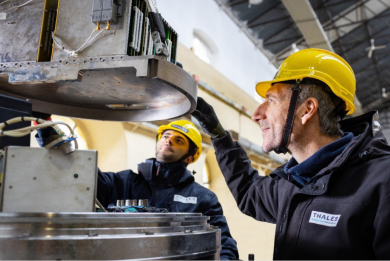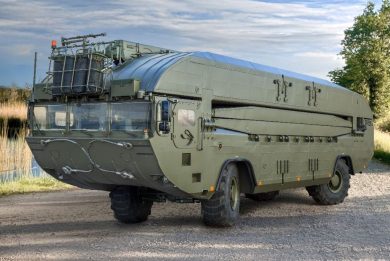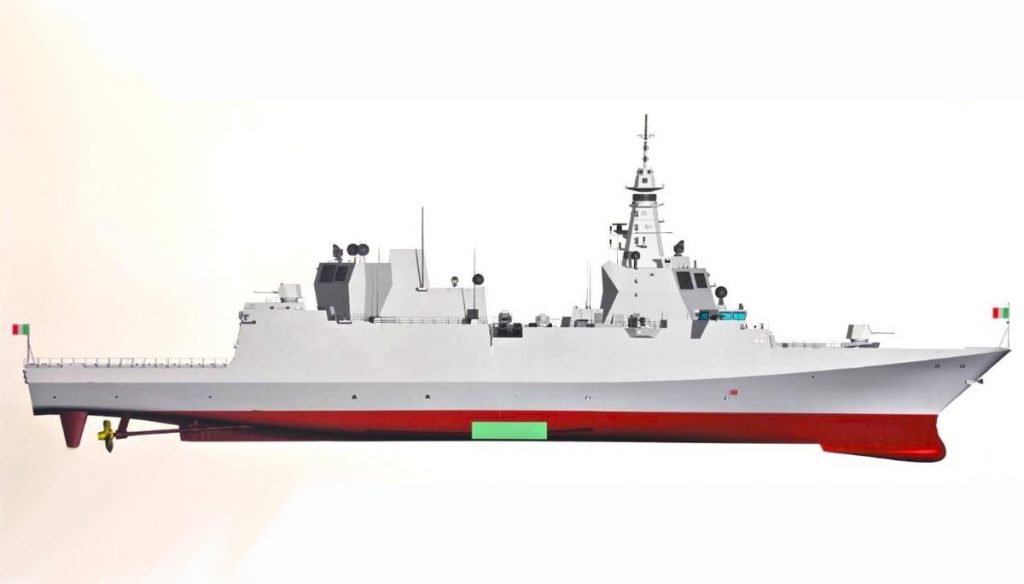
Seafuture 2025 – ELT Group AI-based C-UAS on board Italy’s frigate, a first step towards FREMM EVO IEWS
The ELT Group has provided the Italian MoD with an innovative naval solution to counter unmanned air vehicles (C-UAS) that was installed on board an Italian Navy FREMM frigate deployed in operational missions. A customizable stand-alone suite, it is offered in parallel to a fully integrated electronic warfare suite, already contracted for the FREMM EVO programme
“As part of our roadmap to further innovate and make ELT Group products multi-domain capable, we are introducing artificial intelligence (AI) and cyber resilience features. Among the first innovative applications is the latest generation fully integrated electronic warfare suite (IEWS) for the Italian Navy FREMM EVO programme which incorporates a comprehensive C-UAS capability. It makes the Marina Militare the first among European Navies to embark such integrated solution with the ship combat system and sensors, to counter a wide range of threats including the challenging smaller drones. The latter capability in a stand-alone, modular and readily installable configuration is already available onboard an Italian Navy FREMM frigate deployed in operational missions,” Domitilla Benigni, CEO and COO of ELT Group confirmed to EDR On-Line aside the two-day conference devoted to artificial intelligence and organized by the same company during the Sea Future 2025 maritime exhibition in La Spezia.
No further details were immediately available by the company or the Italian Navy, but after the event the ELT Group confirmed to EDR On-Line that its product portfolio includes both the stand-alone, readily installable and customizable AI-based C-UAS suite to respond to urgent or less demanding requirements, as well as the fully integrated solution already selected and contracted by the Italian Navy for the FREMM EVO programme. The initial C-UAS capability was also more recently confirmed by the Italian Navy without identifying the equipped naval platform.
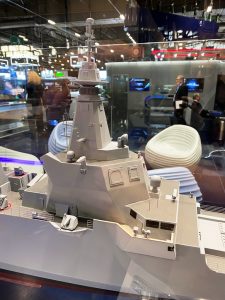
The stand-alone solution could incorporate, based on the requirements, a full suite of sensors including high-capable electro-optics, solid-state 3D lightweight radars with phase array fixed faces, and communication ESM equipment, in addition to a jamming capability for the safely engagement and neutralization of the attacking drone through radio-link smart jamming, GNSS jamming/spoofing techniques in addition to cyber electromagnetic attack techniques, in an operational scenario characterized by several attacking drones. The sensors and jammer suite could be managed by a stand-alone advanced command and control system that can be interfaced with the ship’s command management system (CMS). As remarked by the ELT Group CEO and COO, the new naval C-UAS integrates AI algorithms to enhance and speed up the detection, classification, and identification of smaller drones.
While the EO, radar and ESM (depending on the application) – positioned on the ship to ensure 360° or sectorial coverage – are provided by a pool of already selected third-party suppliers, the integration and command and control is provided by ELT Group based on the know-how and experience accumulated in over a decade, initially with the land-based and then also naval ADRIAN (Anti-Drone Interception Acquisition Neutralization) and more recently with KARMA (Kinetic Anti-Drone Mobile Asset) C-UAS systems. The latter is a rapidly deployable, modular and scalable, electromagnetically silent system that comes in both mobile and fixed configurations, capable of detecting, classify and identify Class 1 and 2 UAS, through AI-based algorithms that increase the effectiveness of on-board sensors and effectors and thus system performance, with a command and control characterized by simple and intuitive Human Machine Interface (HMI).
During the Euronaval 2024 exhibition, ELT Group and Orizzonte Sistemi Navali (OSN) joint venture between Fincantieri and Leonardo, the prime contractor for the FREMM EVO programme managed by OCCAR on behalf of Italian MoD, signed the contract for an advanced C-UAS suite to be fully integrated into the new Electronic Warfare Suite (EWS) with conformal antennas for the latest FREMM configuration adopted by the Italian Navy. Signed in July 2024, the FREMM EVO contract between OCCAR and OSN regards two ships to be delivered respectively in 2029 and 2030. The FREMM EVO configuration maintains the same hull and propulsion arrangement of the in-service Bergamini-class but features new reduced radar cross section superstructures to accommodate the same combat system including the sensors, surface, air and ballistic missile defence weapon systems package installed on board the Thaon di Revel-class Multi-Purpose Combat Ship (MPCS/PPA) in the full combat configuration. The FREMM EVO combat system is centred on the Leonardo SADOC 4 CMS, the Kronos Dual-Band Radar (DBR) with AESA C- and X-band four fixed-faces antenna (FFAs) radars, conformal IFF, the new integrated EWS and new C-UAS radar also with FFAs, Distributed Static Staring Infrared Search and Tracking (DSS-IRST) and EO/radar gun fire controls. These are distributed along the ship two main superstructures, the forward one also featuring the integrated mast.
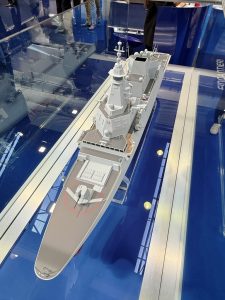
The C-UAS system, according to ELT Group, features innovative capabilities for detecting and countering drone threats, based on assets developed and dedicated specifically for counter-drone operations, such as Cyber RF techniques, AI algorithms, and jammers. Its effectiveness is enhanced through the integration with the EWS suite (RESM, CESM, RECM and the EMSO C2) capabilities. The fully integrated solution is also capable to operate in a stand-alone mode thanks to a C-UAS dedicated C2 component.
The new IEWS suite by ELT Group features a RESM/CESM antennas arrangement similar to that of the MPCS/PPA, EDR On-Line assuming together with additional unidentified antennas for the detection and identification of RF communications associated with attacking drones. The information provided by these systems and by the new dedicated C-UAS radar, to be contracted separately by OSN as part of the combat system, the DSS-IRST suite and guns EO/radar fire controls, together with other data coming from DBR and EWS suites, are processed through the use of AI-based algorithms at the EMSO C2 level, providing the best countering capabilities through the use of dedicated jammer modules, EDR On-Line assumes.
The other innovative aspects of the new IEWS for the FREMM EVO are the “conformal” or fixed face used by the antennas front-end and jammer antenna units installation for the RECM suite. Although ELT Group hasn’t provided details, it is understood to have developed a new installation solution which uses the same system architecture and powerful GaN state-of-the art modules of the previous RECM iteration installed on the MPCS/PPA, replacing the externally positioned jammer antenna units equipped with protuberant antennas front-end with jammer antenna units installed inside the ship structure and fixed-faces or “conformal” antenna front-end. EDR On-Line assumes this solution could contribute to lowering the ship radar cross section as well as easing installation and improving system performances and reliability. Although ELT Group hasn’t provided further details, according to the ship model presented at Euronaval 2024 and Seafuture 2025, “conformal antennas” were visually identified being installed on the right corner of the integrated mast and the left corner of the hangar structure, looking from the ship stern. The presence of a pair of “conformal antennas” in each position without further details, could indicate an extension of jamming capabilities to counter new and emerging threats, such as new missile RF guidance and drone data links.
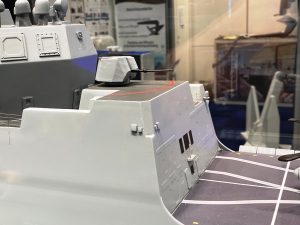
The IEWS core part is the EMSO C2, exercising the Distributed Electromagnetic Surveillance (ES) and providing a valuable contribution to the Maritime Domain Awareness, according to ELT Group. The EW Manager is the computer-aided command and control system integrating all electronic warfare subsystems including the C-UAS suite and taking care of the system cyber security. Threat information can be fused via the EW Manager and shared with CMS or other end-users, including manned and unmanned assets.
During another conference at Seafuture 2025, ELT Group CEO and COO also highlighted new products for the naval domain. She mentioned the DIRCM to counter IR-guided missiles (together with expandable countermeasures to jam IIR seeker, EDR On-Line assumed, as the same combination is used on the air platform protection), together with the Zenital Jammer to counter threats such as ballistic and diving missiles, but also the Synthetic Aperture Radar (SAR) installed on board the satellites, in the latter case to counter adversary reconnaissance and intelligence capabilities.
The new Multi-year Defence Planning Document (DPP, Documento Programmatico Pluriennale della Difesa) 2025-2027 provides further funding for the naval C-UAS programme launched by the Italian MoD with the previous 2024-2026 plan, covering almost the entire request of initial funding, totalling around € 190 million. According to the planning document, it includes both conventional and direct energy weapon systems to counter the UAS threat and will be integrated into the combat system of the Italian Navy naval platforms.
Graphic courtesy OCCAR, photos by L. Peruzzi

